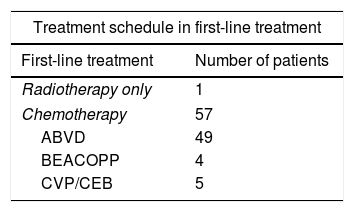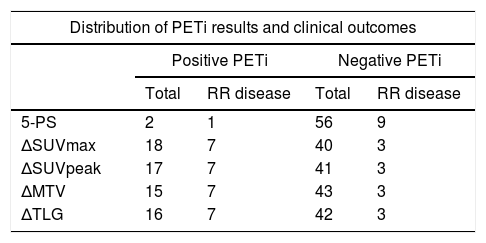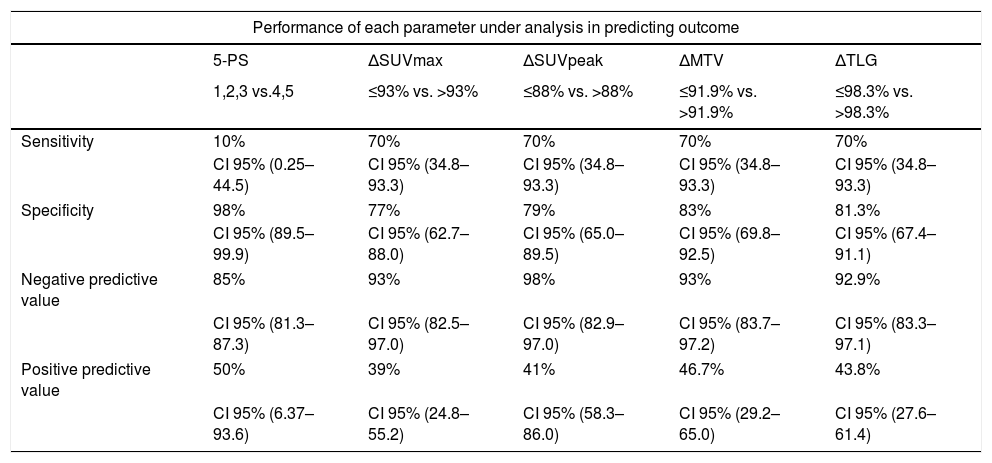To investigate the prognostic value of interim PET (PETi) in adult HL patients, comparing visual with semiquantitative analysis.
Material and methodsRetrospective analysis of Hodgkin's lymphoma (HL) patients diagnosed between 2012 and 2016 in the Onco-hematology Department of Instituto Português de Oncologia – Porto (median follow-up: 46.5 months [2.6–66.4]). Fifty-eight patients with available PET at diagnosis (PET0) and PETi data were included. PETi scans were analyzed according to Deauville 5-point scale (5-PS), and cut-off values for changes in maximum standardized uptake value [SUVmax], peak SUV [SUVpeak], metabolic tumour volume [MTV] and total lesion glycolysis index [TLG] between PETi and PET0 were computed using ROC analysis. Visual and semiquantitative data were compared with each other in the prediction of patient outcomes.
ResultsSemiquantitative analysis obtained a higher sensitivity for persistent/relapsed disease compared to the 5-PS (70% vs. 10%, respectively), but lower specificity. It also demonstrated better predictive performance for response to first-line therapy (negative predictive value >92%). The positive predictive value was similar for all five measurements.
At 60 months of follow-up, there was a significant difference between the progression free survival (PFS) curves of patients with positive and negative PETi according to ΔSUVmax (56.9% vs. 88.0%, p<0.05), ΔSUVpeak (55.9% vs. 88.1%, p<0.05), ΔMTV (35.3% vs. 88.7%, p<0.05), and ΔTLG (42.4% vs. 88.1%, p<0.05). Statistical significance was not reached when considering 5-PS results.
DiscussionPETi interpretation according to a semiquantitative approach appears to discriminate HL patients better than the visual 5-PS analysis. This could allow better detection of persistent or early relapsed disease, while a negative PETi result could support de-escalating therapy intensity.
Investigar el valor pronóstico del PET provisional (PETi) en pacientes adultos con HL, comparando el análisis visual con el semicuantitativo.
Material y métodosAnálisis retrospectivo de pacientes con Linfoma de Hodgkin (LH) diagnosticados entre 2012 y 2016 en el Departamento de Oncología del Instituto Portugués de Oncología - Oporto (mediana de seguimiento: 46,5 meses [2,6–66,4]). Se incluyeron 58 pacientes con PET disponible en el momento del diagnóstico (PET0) y PETi. Las exploraciones de PETi se analizaron de acuerdo con la escala de 5 puntos de Deauville (5-PS), y los valores de corte para los cambios en el valor máximo de captación estandarizada [SUVmax], el SUV máximo [SUVpeak], el volumen tumoral metabólico [MTV] y el índice de glicólisis de la lesión total [TLG] entre el PETi y el PET0 se calcularon mediante el análisis ROC. Los datos visuales y semicuantitativos se compararon entre sí en la predicción de los resultados de los pacientes.
ResultadosEl análisis semicuantitativo obtuvo una mayor sensibilidad para la enfermedad persistente/recidivante en comparación con el 5-PS (70% vs. 10%, respectivamente), pero una menor especificidad. También demostró un mejor rendimiento predictivo para la respuesta a la terapia de primera línea (valor predictivo negativo >92%). El valor predictivo positivo fue similar en las cinco mediciones.
A los 60 meses de seguimiento, hubo una diferencia significativa entre las curvas de supervivencia libre de progresión (PFS) de los pacientes con PETi positivo y negativo según SUVmax (56,9% vs. 88,0%, p<0,05), ΔSUVpeak (55,9% vs. 88,1%, p<0,05), ΔMTV (35,3% vs. 88,7%, p<0,05), y ΔTLG (42,4% vs. 88,1%, p<0,05). No se alcanzó la significación estadística al considerar los resultados de la 5-PS.
DiscusiónLa interpretación del PETi según un enfoque semicuantitativo parece discriminar mejor a los pacientes con HL que el análisis visual de 5-PS. Esto podría permitir una mejor detección de la enfermedad persistente o de la recaída temprana, mientras que un resultado negativo de PETi podría apoyar la disminución de la intensidad de la terapia.
Artículo

Revista Española de Medicina Nuclear e Imagen Molecular (English Edition)
Comprando el artículo el PDF del mismo podrá ser descargado
Precio 19,34 €
Comprar ahora











